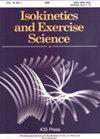The effect of knee angle and subject position on plantar flexors isokinetic performance and muscular activity
IF 0.7
4区 医学
Q4 ENGINEERING, BIOMEDICAL
引用次数: 1
Abstract
BACKGROUND: Assessment of the plantar flexion (PF) isokinetic performance has been greatly diverse and based on personal preferences rather than standardized guidelines. OBJECTIVE: To examine the performance of the plantar flexors under different settings including knee joint angle and subject position. METHODS: Thirteen women and 20 men took part in this study. The isokinetic protocol (60∘/s) was set to ankle movement between 10∘ dorsiflexion to 30∘ PF. Participants performed three repetitions of concentric PF in randomly-ordered knee angles; 15∘, 45∘ and 90∘, and in seated and supine positions. Surface electromyography (EMG) data were collected from the Soleus (SOL) and Gastrocnemius. RESULTS: Knee angle impacted the PF moment (P⩽ 0.001–0.026) and work (P⩽ 0.05) measures in both genders. The moment and work measures were significantly less in the 90∘ than those in the 45∘ and 15∘ positions. The 45∘ position had the highest values, particularly in sitting in the male participants. Only the GL EMG data was significantly impacted (P= 0.017) by the subject position. However, the difference was trivial (1.6%). The SOL muscle showed a consistent pattern of increased activity when the knee was in flexion. CONCLUSION: The 45∘ position seems to be optimal for obtaining the highest isokinetic PF scores.膝关节角度和受试者位置对跖屈肌等速运动和肌肉活动的影响
背景:足底屈曲(PF)等速性能的评估有很大的多样性,并且基于个人偏好而不是标准化的指南。目的:研究足底屈肌在不同设置下的性能,包括膝关节角度和受试者位置。方法:13名女性和20名男性参与本研究。等速方案(60∘/s)设置为踝关节在10 \8728背屈至30 \8728 PF之间的运动。参与者在随机顺序的膝关节角度中重复三次同心PF;15、45和90,以及坐姿和仰卧位。从比目鱼肌(SOL)和腓肠肌采集表面肌电图(EMG)数据。结果:膝关节角度影响了两种性别的PF力矩(P⩽0.001–0.026)和工作(P \108 77; 0.05)测量。在90∘位置的时间和工作测量值明显少于在45和15 \8728位置的测量值。45∘的位置具有最高的值,尤其是在男性参与者中。只有GL EMG数据受到受试者位置的显著影响(P=0.017)。然而,差异很小(1.6%)。当膝盖屈曲时,SOL肌肉表现出持续的活动增加模式。结论:45°位置似乎是获得最高等速PF评分的最佳位置。
本文章由计算机程序翻译,如有差异,请以英文原文为准。
求助全文
约1分钟内获得全文
求助全文
来源期刊

Isokinetics and Exercise Science
医学-工程:生物医学
CiteScore
1.20
自引率
14.30%
发文量
37
审稿时长
>12 weeks
期刊介绍:
Isokinetics and Exercise Science (IES) is an international journal devoted to the study of theoretical and applied aspects of human muscle performance. Since isokinetic dynamometry constitutes the major tool in this area, the journal takes a particular interest in exploring the considerable potential of this technology.
IES publishes studies associated with the methodology of muscle performance especially with respect to the issues of reproducibility and validity of testing, description of normal and pathological mechanical parameters which are derivable from muscle testing, applications in basic research topics such as motor learning paradigms and electromyography. The journal also publishes studies on applications in clinical settings and technical aspects of the various measurement systems employed in human muscle performance research.
The journal welcomes submissions in the form of research papers, reviews, case studies and technical reports from professionals in the fields of sports medicine, orthopaedic and neurological rehabilitation and exercise physiology.
 求助内容:
求助内容: 应助结果提醒方式:
应助结果提醒方式:


